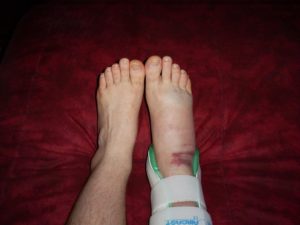Is this your favorite part of the Super Bowl?
This Sunday is Super Bowl Sunday. This could mean one of three things to you. It could mean that there could be a good football game with more of a party than usual or it could mean that there will be some great new commercials to watch with a football game in-between or it could mean absolutely nothing to you.
One of the things that happens during football games are injuries. No one really wants there to be injuries (except for those “dirty” players) but they happen anyway. Injuries can happen in all sports from either accidents, “accidents”, or overuse.
I have often heard of high ankle sprains. Do you know what a high ankle sprain is? I imagine that it is a sprain at the top of the ankle. I imagined that the sprain is above the ankle bone. I didn’t know why this would be different from a regular ankle sprain. Well, if you have wondered about high ankle sprains before, you won’t need to wonder any more.
Your leg has two bones running down the length of it below the knee. There is the tibia and the fibula. These bones come down from the knee and join in the ankle at the talus bone. The connection of these bones is called the ankle joint. There are soft tissues, ligaments and tendons that hold these bones in place. The syndesmotic ligaments are the ligaments that surround the connection of the tibia and fibula and are located more toward the end of the leg than in the ankle.
When the foot is rotated or twisted in outward way, the syndesmotic ligaments can get pulled and as a result stretch or tear. The movements in sports like football, basketball, and soccer – side to side running, starting and stopping your feet repetitively or turning while in motions are common ways to cause a high ankle sprain. Symptoms of a high ankle sprain can include the following:
Pain
Large bruises
Swelling
Inability to put weight on the ankle
Pain when ankle is rotated
It is very important that you see your friendly local podiatrist if you experience any of these symptoms. You will need to be checked to see if you have broken any of the bones in your ankle. The doctor will examine the ankle and order an x-ray of the ankle to check for broken bones.
High ankle sprains take longer to heal especially if there is any displacement between the tibia and fibula. The first phase of treatment is to keep off the foot and treat it with ice and elevation. We have talked about the RICE (rest, ice, compression, and elevation) method before but high ankle sprains actually call for the PRICE method. The addition of protection of the ankle is important with high ankle sprains.
Your doctor’s evaluation will tell you the seriousness of your sprain. The seriousness will determine the length of time you will need for recovery. Your doctor may suggest some exercises for you to do or may suggest that you go to a physical therapist to build up the strength in your ankle. It is important to make sure you give your ankle enough time to heal and that you do the exercises to strengthen the joint. Any joint that has had an injury could be prone to be injured more easily. By taking care of the sprain and giving it time to heal, you may be able to prevent another injury.


